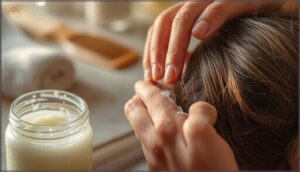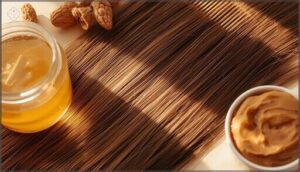This site is supported by our readers. We may earn a commission, at no cost to you, if you purchase through links.
One moment, your child is giggling over stretchy, bouncy Silly Putty—then, the next, you spot a sticky mess tangled in their hair. You’re not alone; more than half of putty-in-hair mishaps happen during regular playtime, and they can turn a calm afternoon into a minor crisis.
Silly Putty’s stubborn grip comes from its unique blend of silicone polymers, which cling to strands and resist ordinary washing. Acting fast matters, but the right approach keeps hair safe and stress low.
If you’re searching for how to get putty out of hair without tears or damage, you’re in the right place for practical, gentle solutions.
Table Of Contents
- Key Takeaways
- What is Silly Putty and Why It Sticks to Hair
- Assessing The Situation Before Removal
- Step-by-Step Methods to Remove Putty From Hair
- Tips for Gentle and Effective Putty Removal
- Aftercare and Preventing Future Incidents
- Frequently Asked Questions (FAQs)
- Why is putty hard to remove?
- How to remove silly putty from hair?
- How to remove slime putty from hair?
- Can putty get stuck in your hair?
- Does conditioner break down Silly Putty?
- How do you break down Silly Putty?
- How do I get putty out of my child’s hair without cutting it?
- What is the difference between silly putty and putty?
- How do I get putty out of my child’s hair if they have sensitive skin?
- Can Silly Putty stain or discolor hair?
- Conclusion
Key Takeaways
- Silly Putty’s silicone polymer composition makes it stick stubbornly to hair, but common household items like baby oil, coconut oil, or conditioner can safely dissolve the bond without cutting.
- Acting quickly matters, but patience and gentle technique prevent hair breakage—always section the hair, work from ends to roots, and use a wide-tooth comb to avoid damage.
- Over 68% of putty-in-hair incidents happen during unsupervised play, so prevention through active supervision, proper storage, and teaching kids about toy safety can stop future mishaps.
- After removal, wash hair with lukewarm water and gentle shampoo, then use conditioning treatments to restore moisture and strength to any stressed strands.
What is Silly Putty and Why It Sticks to Hair
If you’ve ever watched a child play with Silly Putty, you know it’s designed to stretch, bounce, and stick to just about anything. That same quality that makes it fun can turn into a real headache when it winds up tangled in your child’s hair.
Before you grab the scissors, it helps to understand what you’re dealing with and why this gooey toy creates such a sticky situation.
Silly Putty’s Unique Properties
Silly Putty is a viscoelastic polymer—a liquidlike solid made from silicone that behaves like both liquid and solid. Its molecular composition includes dimethylsiloxane and silica, giving it unique sensory features: it stretches slowly, bounces when tossed, and snaps under rapid force.
Many parents buy this putty as a stress reliever for kids, and commercial distribution has reached millions of homes worldwide.
Its thermal behavior changes with temperature, becoming stickier when warm. Silly Putty exhibits both viscous properties under slow deformation.
Common Situations Leading to Putty in Hair
Understanding how putty ends up in hair can help you prevent future incidents. Over 68% of cases happen during unsupervised play, when children get creative with this sticky toy. Naptime is another culprit—27% of incidents occur when kids fall asleep holding putty. Sibling disputes account for 39% of cases, while distracted supervision increases risk by 21%. Even therapy activities with sensory putty can lead to tangles.
One mother found olive oil worked to remove Silly Putty.
Risks of Improper Removal
It’s tempting to yank or scrub when putty gets stuck, but that can backfire fast. Pulling too hard risks hair breakage, while harsh chemicals may trigger scalp irritation or allergic risks. Even leftover oils or peanut butter can cause residue buildup, making hair feel greasy and tangled.
Yanking or scrubbing Silly Putty from hair can cause breakage, scalp irritation, and leave behind greasy, tangled residue
- Hair breakage from forceful combing
- Scalp irritation and chemical exposure
- Residue buildup leading to itching
Assessing The Situation Before Removal
Before you start removing putty from hair, it’s important to take a quick look at what you’re dealing with. A little planning can save you time and help protect the hair. Here’s what you’ll want to check first.
Evaluating The Amount of Putty in Hair
Ever wondered if you’re facing a quick fix or a marathon when removing putty out of hair? Start by evaluating the situation: look at Putty coverage, Penetration depth, Segment length, Section size, and Effort indicator.
Here’s a handy table to help you gauge what you’re up against before diving in:
| Factor | What to Look For |
|---|---|
| Putty coverage | % of hair affected |
| Penetration depth | Surface vs. encased |
| Segment length | cm of strand involved |
| Section size | Number of clumps |
| Effort indicator | Time spent removing |
Identifying Hair Type and Sensitivities
Hair type and scalp sensitivity matter when tackling putty in hair. Curly or coily hair strands often need extra gentle care, as they’re more prone to breakage and dryness. If your child’s scalp is sensitive or has product allergies, choose mild hair treatment options.
Age factors and regional variations can also affect how hair reacts to different removal methods.
When to Seek Professional Help
Before you dive into removing Silly Putty, pause if you notice extensive coverage, scalp injury, or possible chemical exposure. Sometimes, risky attempts at home can make things worse. For instance, if you spot concerning symptoms—like swelling, bleeding, or confusion—don’t wait. Reach out for help if you see:
- Over 25% of hair matted with putty
- Signs of scalp injury
- Unusual symptoms after exposure
Step-by-Step Methods to Remove Putty From Hair
There are several safe ways to get putty out of hair, and you don’t need to panic. Each method uses common household items and simple steps. Here’s what you can try next.
Using Baby Oil
Did you know Baby Oil’s mineral oil can slip Silly Putty right out of hair—like butter on a hot pan? Massage a thin layer onto the stuck area, wait a few minutes, then gently comb through. This oil composition lowers tension, loosening the putty’s grip. Remember, avoid eyes, use only on the spot, and double-shampoo afterward.
| Feeling | Action |
|---|---|
| Relief | Massage gently |
| Hope | Wait patiently |
| Trust | Comb slowly |
| Control | Wash twice |
Applying Hair Conditioner
Did you know using hair conditioner can work wonders for getting Silly Putty out of hair? Conditioner types with dimethicone or botanical oils help soften and slip out the putty.
Try these steps:
- Massage conditioner into the sticky spot
- Use a wide-tooth comb for detangling
- Add warm water for extra slip
- Follow with post-removal care for healthy hair
Removing With Coconut Oil
Did you know coconut oil can dissolve Silly Putty out of hair in just a few minutes? For oil application, use 1–2 tablespoons per section, massage well, and let sit.
This method boosts scalp hydration and protein retention, proven in comparative trials to work faster than conditioner.
Watch for allergic reactions, but most families find coconut oil gentle and effective for removing Silly Putty.
Alternative Methods (Petroleum Jelly, Peanut Butter)
Stuck on Silly Putty removal methods? Petroleum jelly can help slide Silly Putty out of hair, but watch for Jelly Hair Buildup and wash thoroughly.
Creamy peanut butter breaks the bond, yet Peanut Allergies are a concern—check product safety first.
Both boost removal efficiency, but gentle combing protects Hair Health and prevents breakage during the process.
Using WD-40 Safely
If peanut butter isn’t an option, WD-40 can loosen Silly Putty out of hair, but it’s not risk-free. Use just a dab, wear gloves, and avoid spraying directly. Wash hair with shampoo right after, since WD-40 risks include skin irritation and lingering odor.
Industry recommendations stress safe application guidelines and environmental impact—never pour leftovers down the drain.
Tips for Gentle and Effective Putty Removal
Getting putty out of hair can feel tricky, but a gentle approach makes all the difference. You’ll want to protect the hair while working the putty free.
Here are some tips to help you do just that.
Sectioning and Detangling Hair
Think of sectioning as your roadmap for gentle hair care. By dividing hair into manageable parts, you boost detangling efficiency and lower the risk of breakage.
Sectioning benefits all hair types—especially thick or curly strands—by making it easier to assess the situation and target sticky spots.
Using a wide-toothed comb, you’ll protect hair strands and see real damage reduction.
Proper Use of Combs and Tools
After sectioning, reach for a wide-toothed comb—plastic, wood, or carbon all work, but carbon combs offer heat resistance and durability. Use gentle strokes downward to ease Silly Putty out of hair. For smaller areas, a rat-tail comb helps target sticky spots.
Always clean your comb and brush after use; soaking in disinfectant keeps tools safe for next time.
Avoiding Hair Damage and Breakage
Now, as you ease Silly Putty out, remember—gentle techniques matter. Tugging or harsh pulling can damage hair strands and disrupt keratin integrity.
Stick with hair conditioner or mild hair products that support pH balance, avoiding chemical exposure that leads to oxidative stress.
Always start at the ends and work up, keeping breakage low and hair care tips top of mind.
Aftercare and Preventing Future Incidents
Once the putty is out, it’s important to care for your child’s hair and keep future mishaps at bay.
A few simple steps can make all the difference. Here’s what you need to know next.
Washing and Conditioning Hair Post-Removal
Did you know using lukewarm water during hair washing helps minimize damage after putty removal? Choose a gentle shampoo to clear away oil, then apply a conditioner type suited for your child’s hair. Focus on mid-lengths and ends, not the roots.
Stick to your regular washing frequency, and avoid harsh scrubbing—gentle care keeps hair healthy and manageable after mishaps.
Restoring Hair Health
Recovery starts with patience. After putty mishaps, protein treatments and deep conditioning help restore strength and moisture, especially if chemical damage occurred. For severe cases, hair transplants and decontamination effects can be life-changing.
Use gentle hair washing techniques and targeted hair care tips to remove residue and support healing. Consistent hair cleaning keeps strands resilient and encourages healthy regrowth.
Prevention Tips for Parents and Caregivers
With a little planning, you can keep putty out of hair and headaches at bay. Try these proven prevention steps for dealing with children and preventing putty from sticking:
- Supervision techniques—stay close during play.
- Education strategies—talk about toy safety.
- Storage solutions—use sealed containers.
- Safe alternatives—choose hair-safe or non-sticky toys.
- Prompt cleanup—wipe hands and store putty immediately.
Frequently Asked Questions (FAQs)
Why is putty hard to remove?
Like a stubborn knot, Silly Putty grips hair with strong polymer adhesion and dilatant properties. Its solvent resistance and mechanical difficulties mean pulling only worsens residue, risking hair health. That’s why removing putty from hair takes patience and care.
How to remove silly putty from hair?
To remove Silly Putty from hair, massage baby oil or coconut oil into strands, then gently comb with a wide-tooth comb. Conditioner also helps.
Avoid alcohol near sensitive skin. Seek professional intervention if putty is deeply matted.
How to remove slime putty from hair?
Don’t panic—most putty removal myths aren’t true. For emergency putty removal, massage baby oil or conditioner into the hair, then gently comb through.
Professional hair-care experts recommend avoiding harsh DIY putty solvents to protect scalp and hair health.
Can putty get stuck in your hair?
Yes, Silly Putty can get stuck in hair—especially with kids. Its sticky, stretchy composition increases Hair Entanglement and Entrapment Likelihood, making Removal Urgency key for Kids Safety. Warm conditions and unsupervised play raise the risk.
Does conditioner break down Silly Putty?
Conditioner won’t break down Silly Putty’s polymer composition, but its real efficacy comes from lubrication. By coating hair, conditioner helps Silly Putty slide free.
It’s gentler than alternative solvents, making it a safe first step for removal.
How do you break down Silly Putty?
Silly Putty’s silicone polymer bonds resist water, so oil-based breakdown works best.
Baby oil, coconut oil, or peanut butter soften the putty through chemical reactions, making goo removal easier. Solvent effectiveness increases with gentle heat application.
How do I get putty out of my child’s hair without cutting it?
Like untangling a knot in fine jewelry, removing putty requires patience and the right product. Saturate your child’s hair with conditioner or baby oil, wait five minutes, then gently comb from ends upward—Silly Putty removal without scissors.
What is the difference between silly putty and putty?
The toy behaves like both liquid and solid due to its polymer composition and viscoelastic properties, bouncing or flowing depending on stress.
Regular putty fills gaps in construction and doesn’t share these playful characteristics.
How do I get putty out of my child’s hair if they have sensitive skin?
When removing silly putty from hair, choose gentle ingredients like fragrance-free baby oil or conditioner. Patch testing behind the ear reduces allergy risks.
Consider pediatrician advice for soothing aftercare if irritation develops.
Can Silly Putty stain or discolor hair?
Good news: Silly Putty won’t permanently stain or discolor hair. Its silicone-based composition doesn’t dye hair shafts like fabric stains.
You might notice temporary oiliness or residue effects until thoroughly washed, but colored hair remains safe.
Conclusion
Picture your child’s relief as the last stubborn bits of putty slide free, leaving soft, clean hair behind. You’ve learned how to get putty out of hair using safe, household items—no panic, no scissors, no damage.
These methods work because you stayed patient and followed each step carefully. Now you’re prepared for next time, armed with knowledge that transforms a stressful moment into a manageable fix. Your calm response makes all the difference when accidents happen.
- https://www.goodhousekeeping.com/beauty/hair/a36204879/how-to-get-slime-out-of-hair/
- https://vinhairvn.com/how-to-get-slime-out-of-hair/
- https://www.healthline.com/health/how-to-get-gum-out-of-hair
- https://www.reddit.com/r/HairSystem/comments/vabr3m/how_to_wash_all_the_glue_and_adhesive_from_your/
- https://www.mentalfloss.com/article/68467/15-facts-about-silly-putty












